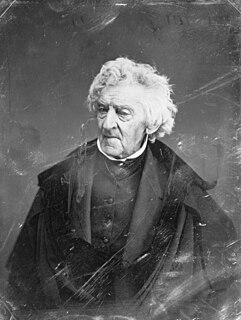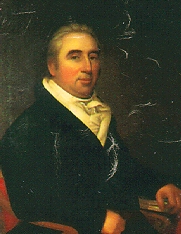Marbury v. Madison, 5 U.S. 137 (1803), was a landmark U.S. Supreme Court case that established the principle of judicial review in the United States, meaning that American courts have the power to strike down laws and statutes that they find to violate the Constitution of the United States. Decided in 1803, Marbury is regarded as the single most important decision in American constitutional law. The Court's landmark decision established that the U.S. Constitution is actual law, not just a statement of political principles and ideals, and helped define the boundary between the constitutionally separate executive and judicial branches of the federal government.

Article Three of the United States Constitution establishes the judicial branch of the federal government. Under Article Three, the judicial branch consists of the Supreme Court of the United States, as well as lower courts created by Congress. Article Three empowers the courts to handle cases or controversies arising under federal law, as well as other enumerated areas. Article Three also defines treason.

The Judiciary Act of 1789 was a United States federal statute enacted on September 24, 1789, during the first session of the First United States Congress. It established the federal judiciary of the United States. Article III, Section 1 of the Constitution prescribed that the "judicial power of the United States, shall be vested in one Supreme Court, and such inferior Courts" as Congress saw fit to establish. It made no provision for the composition or procedures of any of the courts, leaving this to Congress to decide.

William Cranch was a United States circuit judge and chief judge of the United States Circuit Court of the District of Columbia. A staunch Federalist and nephew of President John Adams, Cranch moved his legal practice from Massachusetts to the new national capital, where he became one of three city land commissioners for Washington, D.C., and during his judicial service also was the 2nd Reporter of Decisions of the Supreme Court of the United States and a Professor of law at Columbian College.
The Midnight Judges Act represented an effort to solve an issue in the U.S. Supreme Court during the early 19th century. There was concern, beginning in 1789, about the system that required the Justices of the Supreme Court to "ride circuit" and reiterate decisions made in the appellate level courts. The Supreme Court Justices had often expressed concern and suggested that the judges of the Supreme and circuit courts be divided. The Act was repealed by Congress on January 22, 1802.
The United States circuit courts were the intermediate level courts of the United States federal court system from 1789 until 1912. They were established by the Judiciary Act of 1789, and had trial court jurisdiction over civil suits of diversity jurisdiction and major federal crimes. They also had appellate jurisdiction over the United States district courts. The Judiciary Act of 1891 transferred their appellate jurisdiction to the newly created United States circuit courts of appeals, which are now known as the United States courts of appeals. On January 1, 1912, the effective date of the Judicial Code of 1911, the circuit courts were abolished, with their remaining trial court jurisdiction transferred to the U.S. district courts.
In the United States, circuit riding was the practice of a judge, sometimes referred to as a circuit rider, traveling to a judicial district to preside over court cases there. A defining feature of American federal courts for over a century after the founding of the United States, circuit riding has since been mostly abolished. The term, however, lives on in the name "circuit court", a colloquialism commonly used to refer to the United States courts of appeals.
The Judiciary Act of 1802 was a Federal statute, enacted on April 29, 1802, to reorganize the federal court system. It restored some elements of the Judiciary Act of 1801, which had been adopted by the Federalist majority in the previous Congress, but was repealed by the Democratic-Republican majority earlier in 1802.

William Marbury was a highly successful American businessman and one of the "Midnight Judges" appointed by United States President John Adams the day before he left office. He was the plaintiff in the landmark 1803 Supreme Court case Marbury v. Madison.

In the United States, judicial review is the legal power of a court to determine if a statute, treaty, or administrative regulation contradicts or violates the provisions of existing law, a State Constitution, or ultimately the United States Constitution. While the U.S. Constitution does not explicitly define the power of judicial review, the authority for judicial review in the United States has been inferred from the structure, provisions, and history of the Constitution.

The Marshall Court refers to the Supreme Court of the United States from 1801 to 1835, when John Marshall served as the fourth Chief Justice of the United States. Marshall served as Chief Justice until his death, at which point Roger Taney took office. The Marshall Court played a major role in increasing the power of the judicial branch, as well as the power of the national government.

John Marshall was an American politician and lawyer who served as the fourth chief justice of the United States from 1801 until his death in 1835. Marshall remains the longest-serving chief justice and fourth-longest serving justice in Supreme Court history, and he is widely regarded as one of the most influential justices to ever sit on the Supreme Court. Prior to joining the Supreme Court, Marshall served as the fourth United States Secretary of State under President John Adams.
John Pickering was President of New Hampshire, Chief Justice of the New Hampshire Superior Court of Judicature and a United States District Judge of the United States District Court for the District of New Hampshire. He was the second federal official impeached by the United States House of Representatives and the first person convicted and removed from office by the United States Senate.
United States v. More, 7 U.S. 159 (1805), was a United States Supreme Court case in which the Court held that it had no jurisdiction to hear appeals from criminal cases in the circuit courts by writs of error. Relying on the Exceptions Clause, More held that Congress's enumerated grants of appellate jurisdiction to the Court operated as an exercise of Congress's power to eliminate all other forms of appellate jurisdiction.
Circuit riding was one of the responsibilities of U.S. Supreme Court justices during the Marshall Court (1801–1835). Under the Judiciary Act of 1801, the United States federal judicial districts were divided into six United States circuit courts—one for each justice. Rather than appointing separate circuit judges, the circuit courts were staffed by a combination of the resident United States district court judges from that district and the Supreme Court justice assigned to that circuit.

A certificate of division was a source of appellate jurisdiction from the circuit courts to the Supreme Court of the United States from 1802 to 1911. Created by the Judiciary Act of 1802, the certification procedure was available only where the circuit court sat with a full panel of two: both the resident district judge and the circuit-riding Supreme Court justice. As Chief Justice John Marshall wrote, he did not have "the privilege of dividing the court when alone."






